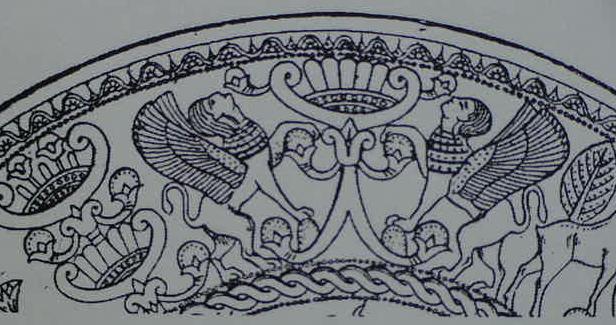Two Cherubim (Phoenician Winged Sphinxes) guard the Sacred Tree, or "Lebensbaum"
("Tree of Life"). From a silver plate from Curium, Cyprus, ca. the 7th century BCE (cf. p. 74. Fig. 207. Heinz Demisch. Die Sphinx, Geschichte ihrer Darstellung von den Anfangen bis zur Gegenwart. Stuttgart. Verlag Urachhaus Johannes M. Mayer. 1977 (ISBN 3-8738-219-7).
Note: The Phoenician version of the Tree of Life, was a hybrid of Egyptian Lotus and Papyrus blossoms, as these plants were, for the Egyptians associated with the righteous dead attaining eternal life. The Egyptians showed themselves holding a Lotus blossom to their nose, symbolic of immortality. They believed that the Sun-god arose each day from a giant Lotus blossom, and they too would arise from death, from the same flower, for ever and ever, like the Sun-god. At times, especially in North Syrian art forms, the Phoenician tree possesses Palm branches, creating a fusion of Lotus, Papyrus and Palm tree. The Bible mentions the Temple of Solomon being decorated with Cherubim and Palm trees. The capital volutes found in Iron AGE II Israel resemble Phoenician and North Syrian Sacred Trees. Evidently Israel's Sacred Tree of Life is drawing from the North Syrian version with its Palm branches.
As regards the Sphinx, Hebrew Cherub, the Egyptians understood it was a manifestation of the Sun-god, it was called Hor-em-akhet, "Horus on the Horizon," that is, the Sun at Sunrise was the Sphinx. The Sun arose each day after traveling all night in the underworld, to emerge at daybreak from a giant Lotus blossom, thus the sphinx in association with a Lotus Tree (a "fantastic creation, as Lotuses are aquatic plants), is a quite normal and understandable motif, which was reformatted by the Phoenicians, who built the Temple of Solomon and decorated it with Cherubim, flowers, and sacred trees. One also frequently sees a winged Sun over the sacred tree in Phoenician seals. The Winged sun was called by the Egyptians "Horus of Behdet," Horus assuming the shape of the Sun with wings to destroy his enemies. So, Horus the hawk god is the Sun and the Sphinx, both of whom, who emerge each day from the sacred Lotus. Malachi metaphorically speaks of Yahweh-Elohim as a winged sun disk with righteousness in its wings (Mal 4:2). Egyptian Solar Imagery appears to have been ascribed by the Hebrews to their God.
